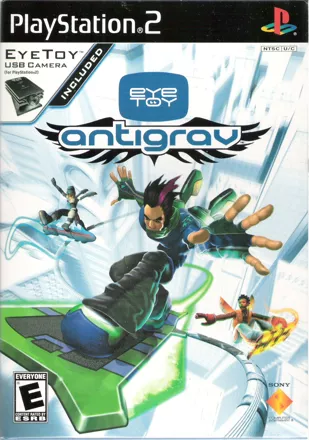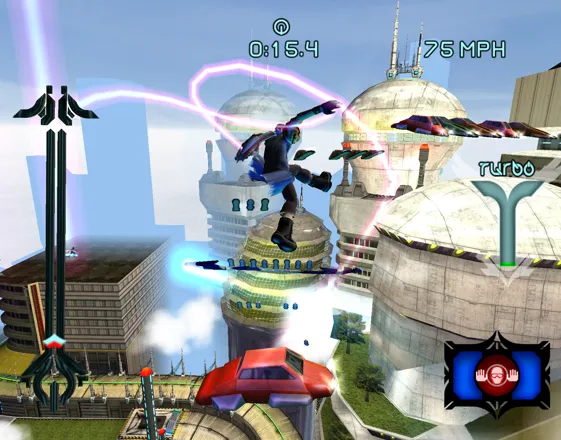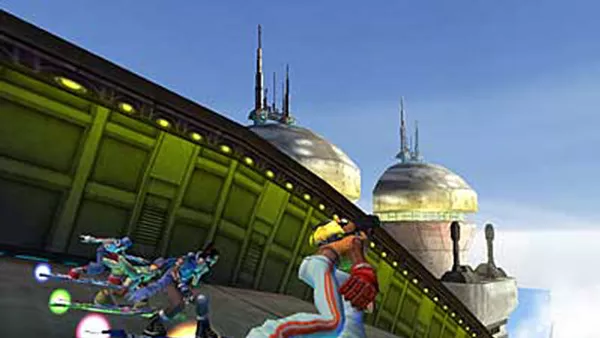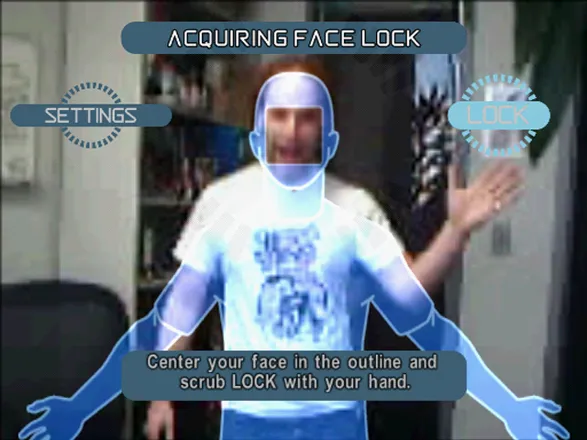EyeToy: AntiGrav
Description official description
EyeToy: AntiGrav is the first full-fledged game for the PS2 Eyetoy camera peripheral. Using a head-and-hands body recognition system, the onscreen character responds to the control of the player's body movements. Take one of 8 hoverboarders through 5 tracks ranging from a run-down Chinese wharf to an intense professional hoverboarding arena. And while it is an "extreme" sports boarding game, the gameplay contains flavors of SSX, DDR, Stun Runner, a little Return of the Jedi, and a lot of other influences. Of course, it is the uniqueness of the controls that drives the design of the game, the experience of the game, and ultimately whether or not the player enjoys it.
Groups +
Promos
Credits (PlayStation 2 version)
139 People (124 developers, 15 thanks) · View all
| Project Leader | |
| Executive Producer | |
| Lead Programmers | |
| Art Director | |
| Audio Director | |
| Producer | |
| Programmers | |
| Additional Programming | |
| Game Systems Design | |
| Lead Level Designer | |
| Level Designers | |
| Dialogue | |
| Lead Level Artist | |
| Level Artists | |
| Object Artist | |
| [ full credits ] | |
Reviews
Critics
Average score: 69% (based on 17 ratings)
Players
Average score: 3.2 out of 5 (based on 6 ratings with 1 reviews)
Way ahead of its time, and highly underrated.
The Good
Motion controlled games are all the rage these days, but back in 2004, only one company was attempting to bring gamers immersive, full-body experiences: Sony, with their camera peripheral, the EyeToy. Long before the Kinect was even a thought in some Microsoft corporate executive's mind, and even before Nintendo broke gaming barriers with the Wii Remote, the EyeToy was the first peripheral to allow for quality motion gaming on a home console. But while most games for the peripheral were simple, casual party titles, there was one attempt to make a deeper, richer, and ultimately more rewarding experience for more seasoned players: EyeToy Antigrav.
Antigrav is an extreme sports racing title set in the far future, where hoverboards and flying cars have become reality. The urban jungle has become a playground for boarders to jump, grind, and fly around as they compete with each other for points and time.
While this game could have been made with a controller in mind, it wouldn't have been anything special. However, by designing it around the motion controlled camera, it becomes an entirely different and truly spectacular experience that just has to be played to be believed.
Rather than use boring analog sticks and buttons to control your rider, you actually get to use your entire body to control the game. Leaning from left to right controls the turning of your rider. Ducking causes your rider to duck, while jumping causes your rider to jump. Jumping is delayed, but it is intentional (the game tells you this) and you'll soon get the timing down with ease. Waving your arms activates tricks, and you can pull off special moves by waving your arms according to the directions at the bottom of the screen. How it all works is that before a race begins, the game will lock on to your face. It tracks the movement of your face to determine your position on the screen. So, if your face leaves the camera's viewpoint from the top of the lens, that will tell the game to jump, hence the delay.
There are several different kinds of activities that take place at any given moment during gameplay. Most of the time, you'll be steering to try and reach the various ramps and rails that liter the environment. If you hit a rail, you have to reach out with your arms to hit patterns of targets, some of which require expert reflexes and timing to hit. You'll also be ducking and jumping over obstacles while grinding on rails as well. Some targets, if successfully hit, open up alternate routes on the rails, which can net you even more points.
Finally, there are the flight pads. When you hit one, you can freely fly around on your board, trying to fly through rings for the most points. Think of your head as a joystick- moving it around causes your rider to do the same on his board. Flight sections are the most challenging part of the game to get used to, as the controls are very loose and floaty, but you'll eventually find them to work just as well as anything else in the game.
Antigrav departs from other EyeToy games by not showing your face on the screen except during menus. Instead, the game tracks your face as well as the location of your hands in an indicator in the bottom right hand corner of the screen. You'll need to pay attention to this at all times if you want to win, as this is where the game tells you where it thinks your face is. While it's not 100% perfect, it is still very workable and you'll soon learn to adjust to its quirks.
You can play the game in two modes. In race mode, you attempt to beat other riders down the mountain, and in trick mode, you try to beat a high score by pulling off tricks.There are five tracks in the game, and while that is a disappointingly slim number for a console game, each track is at the least very memorable and highly dense. All of the tracks offer multiple routes through them, and each one is progressively more complex than the last, The last track, Black Rock Ridge in particular is extremely epic. You start at the top of a mountain peak, zoom down at rocket-fast speeds, head through a canyon and a volcano, and finish by going around rails literally twisting through the treetops. It's one of the most exhilarating track designs I've ever seen in a racing game, and the first time you go down it you will be amazed. Another great track is the Aerodrome, which also features a ridiculous variety of environments, and is highly unique for being the only lap based track in the game. Really though, all of the tracks are great.
Finally, the music is also excellent. The score has an almost spy movie quality to it, and it changes depending on what you;re doing in the game. If your'e just riding along, it will be bombastic and fast paced, but if you're flying, it turns mellow. The dynamic soundtrack for this game is simply ingenious.
The Bad
As good as the music is, the sound is something of a mixed bag. The dialogue from the riders is a cheesy and laughable attempt to emulate the attitude of other extreme sports games. The sounds while you're riding can also be somewhat cheesy as well, especially the wind-whipping sounds when you're pulling off tricks.
While I thought the game was quite beautiful when I first played it, the graphics are pretty average overall for the PS2. Environments are rather blocky, even for the time, and dated motion-blur and simplistic models do little to impress. I was in such awe of the art direction and environments that I completely failed to notice just how poor the game's engine was. The game does offer a rock solid framerate at least, and it is still technically the best looking game designed for EyeToy.
The game is also incredibly short. I mentioned earlier that the game only has five tracks. You can play each track in either speed, or trick mode. That means that there are just ten levels for the entire game, which again, seems very lacking for a PS2 game. While the learning curve is initially steep, once you master it you may find very little reason to want to come back to the game.
Now, we come to the elephant in the room: the EyeToy itself. To put it mildly, the thing isn't the most reliable peripheral around. You're going to have to turn on every light in the living room and open all of the windows if you want to play the game at all. And this game NEEDS light so it can distinguish your face from the image. More than any other EyeToy game out there, this one is incredibly light-hungry. Playing in a darkened room simply is not possible. In addition, moving objects in the background can occasionally trick the game into doing something that you didn't intend for it to do. Be prepared to yell at friends, family members, and even pets for screwing up an almost perfect run.
The Bottom Line
But when you're all alone, in a light saturated room with absolutely no distractions, the game just works, and you'll quickly realize that there simply just isn't anything like this out there, even now.
While the aesthetics are underwhelming and the game needs stringent conditions to play, Antigrav is a simply astounding title overall and one of my personal favorite games on the PS2 period. It's a game that is incredibly ahead of its time, yet it's a game that no one talks about anymore. That's a shame, as I feel this is one of the most important titles in the history of motion controlled gaming. Antigrav also proves that Harmonix, who usually specializes in music-based games and applications, can develop great games in whatever genre they please.
Antigrav is such a good title, that it would be worth getting an EyeToy and a PS2 just to play it.
PlayStation 2 · by krisko6 (814) · 2012
Analytics
Related Sites +
-
EyeToy: AntiGrav
Official game website -
Wikipedia: EyeToy: AntiGrav
Information about EyeToy: AntiGrav at Wikipedia
Identifiers +
Contribute
Are you familiar with this game? Help document and preserve this entry in video game history! If your contribution is approved, you will earn points and be credited as a contributor.
Contributors to this Entry
Game added by Chris Canfield.
Additional contributors: DreinIX.
Game added November 17, 2004. Last modified April 3, 2025.















